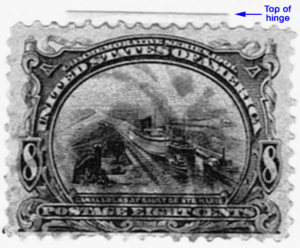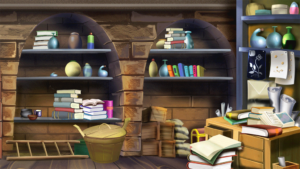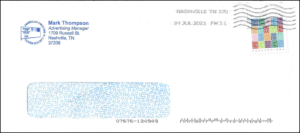The Do’s & Don’ts of Philately — With an Emphasis on The Latter
By John M. Hotchner
There are any number of “How To” books created over the years to help the beginner to learn about collecting stamps. They are bright, cheerful, accurate and helpful — so far as  they go. But most of them don’t go to the trouble of warning the new collector off certain practices and behaviors that can result in a rude shock as the new collector gains experience, builds a collection, and eventually shares it with other collectors.
they go. But most of them don’t go to the trouble of warning the new collector off certain practices and behaviors that can result in a rude shock as the new collector gains experience, builds a collection, and eventually shares it with other collectors.
Only then are they likely to find out the unexpected consequences of doing what seemed reasonable early in their philatelic life; hopefully at a time before they have put serious money into a collection. So, I thought I’d devote this column to outlining some of the “Dont’s” of stamp collecting, and we’ll jump right in with:
Your album: Whether you use a printed album, or blank sheets of paper, don’t lick the back of your stamps and paste them down on the paper; not even just a corner. This ruins the value of mint stamps, and makes it likely that you will “thin” even used stamps if/when you try to take them off. The same is true of using cellophane or other sticky tape or gummed labels. Use only “stamp hinges” made for the purpose. Also, don’t use self-stick photo albums for stamps or covers. The part that starts out sticky ages over time, and stains the back of the philatelic material.
Using hinges: Some collectors put the hinge in the middle of the stamp, fold it over, and  lick the part that will adhere to the page. In doing so they get moisture on the stamp, which then sticks the stamp as well as the hinge to the paper. Hinges should be placed flush with the top of the stamp; or as my father taught me, fold the hinge first, and carefully place it so that there is a millimeter of space between the fold and the stamp, as shown nearby. [You can click on this picture to make it bigger.] I’d add that collectors should not be eating, drinking, smoking or vaping while hinging. Whatever is in your mouth, from chemicals to salt to artificially-colored cherries, will transfer to the hinge, and maybe to the stamp. Unless the collector is extremely careful, the stamp may get stained.
lick the part that will adhere to the page. In doing so they get moisture on the stamp, which then sticks the stamp as well as the hinge to the paper. Hinges should be placed flush with the top of the stamp; or as my father taught me, fold the hinge first, and carefully place it so that there is a millimeter of space between the fold and the stamp, as shown nearby. [You can click on this picture to make it bigger.] I’d add that collectors should not be eating, drinking, smoking or vaping while hinging. Whatever is in your mouth, from chemicals to salt to artificially-colored cherries, will transfer to the hinge, and maybe to the stamp. Unless the collector is extremely careful, the stamp may get stained.
If you care about the resale value of your stamps, don’t hinge modern mint or older stamps that have value (anything with a value over 25¢ in the Scott Catalogue). When it comes time to sell a collection, the competition and prices offered will be a good deal reduced if mint stamps are hinged.
Mounts for mint (or any other) stamps: If you use mounts for your stamps, don’t buy the cheapest ones you can find, and do ask your philatelic supplier if the mount itself and the part of the mount that sticks to the page will hold up over time. Avoid Crystal Mounts, a product that is no longer available but may lurk in accumulations or old collections you acquire. They shrink over time, “crunching” the stamps within; and the adhesive can discolor and stain your stamps.
Storage: Moisture is an enemy, as are rodents and other smaller pests that find paper a tasty treat. Don’t store your stamps where they will be exposed to moisture, even  moderate amounts. In this category are basements where there is a seepage or humidity problem. Always avoid storage on the floor or even close to the floor; and directly against external walls that are below ground level.
moderate amounts. In this category are basements where there is a seepage or humidity problem. Always avoid storage on the floor or even close to the floor; and directly against external walls that are below ground level.
If possible, avoid any space where there is no air conditioning. And don’t place albums or mint sheet files one on top of the other. They should be stood up vertically with some breathing space between them.
Why? Pressure combined with moisture will stick your stamps to the album page or each other, and can discolor stamps.
When you work on your stamps: As noted above, food or anything else that can get onto your hands and stain your stamps/covers, or spill onto your workspace should be avoided. If you use watermark fluid, or some other chemical for watermarking or separating self-stick stamps from paper, do your due diligence to make certain they are not toxic or flammable. Even then, don’t use them in confined spaces where there is little movement of air. There is risk to inhaling chemicals.
Working with stamps: Don’t “reduce” items you have to be able to fit them into an album space. The two biggest problems here are blocks and imperforate stamps. Blocks of mint  or used stamps, especially those issued before 1950, are likely to have extra value as blocks. Removing a single stamp to place in an album ruins the value of the block.
or used stamps, especially those issued before 1950, are likely to have extra value as blocks. Removing a single stamp to place in an album ruins the value of the block.
The standard for collecting imperforate stamps is pairs, but a great many albums have space only for a single. Collectors may be tempted to cut a single from a pair or strip of imperfs (or even worse, a block). Don’t, unless you truly care nothing about resale value. And even then, for stamps from the beginning of stamps to roughly the 1920s, you may be ruining a scarce item.
An additional problem has come along recently with the increased number of stamps that can’t be washed off paper: clipping them from the envelope. Many collectors try to save weight by clipping very close to the stamp, and if not careful, into the stamp. Stamps with their perforations clipped off are damaged and worthless. Allow a couple of millimeters of paper all the way around.
When you work with covers: Typically, new stamp collectors have little or no interest or appreciation for the envelopes that carried stamps through the mail (unless the collector  began as a First Day Cover collector). Thus, covers are seen as a source for stamps for the album, not as objects of interest in themselves. Don’t cut the stamps off every cover you get! The older the cover, the more likely it is to have value as a cover, but even modern covers can have value if the stamp on it is unusual, if it has decorations, postal markings showing some sort of special handling in the mail, or was readdressed and forwarded. [The window envelope shown here is actually a first day cover.]
began as a First Day Cover collector). Thus, covers are seen as a source for stamps for the album, not as objects of interest in themselves. Don’t cut the stamps off every cover you get! The older the cover, the more likely it is to have value as a cover, but even modern covers can have value if the stamp on it is unusual, if it has decorations, postal markings showing some sort of special handling in the mail, or was readdressed and forwarded. [The window envelope shown here is actually a first day cover.]
Don’t join a stamp club! (I hope you appreciate the wry humor here.) Not getting involved with other collectors is probably the worst decision a collector can make. The most effective way of learning about the hobby, including its do’s and don’ts, is to befriend other collectors. A stamp club is the perfect place to make those connections.
Should you wish to comment on this editorial, or have questions or ideas you would like to have explored in a future column, please write to John Hotchner, VSC Contributor, P.O. Box 1125, Falls Church, VA 22041-0125, or email, putting “VSC” in the subject line.
Or comment right here.




The one thing I find missing from this well written advice, is especially important for young/new collectors. They should be informed of other ways (beyond an album) that stamp collecting could be accomplished. I personally have never liked albums. I prefer an organized accumulation. What other ways are there for storing stamps such as in glassines envelopes, show cards, etc. These storage alternatives can then be placed in acid-free envelopes with all the needed identification information carefully and neatly printed on the envelope, i.e. Scott number, name, series, denomination, type (coil, booklet, sheet) and quantity of the variety enclosed in the envelop, and used or mint condition. Obviously, this is just my preferred way of collecting but I’m certain there are others and would certainly like to hear from other collectors.
Good points all thanks for the response. John